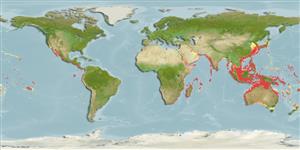Common names from other countries
>
Scombriformes (Mackerels) >
Scombridae (Mackerels, tunas, bonitos) > Scombrinae
Etymology: Sarda: Latin and Greek, sarda = sardine; name related to the island of Sardinia (Ref. 45335).
More on authors: Temminck & Schlegel.
Environment: milieu / climate zone / depth range / distribution range
экология
морской; мигрирует в океане (Ref. 51243); пределы глубины 1 - 167 m (Ref. 58302). Subtropical; 14°C - 23°C (Ref. 168); 43°N - 41°S, 24°E - 77°W (Ref. 168)
Indo-Pacific: widespread but with many gaps in its known distribution. Eastern Pacific: Hawaiian Islands and Pacific coast of USA to southern tip of Baja California and Tres Marias Islands extending to Cabo Blanco, Peru (especially during El Niño events), the Galapagos Islands and Gulf of Guayaquil.
Length at first maturity / Size / Вес / Возраст
Maturity: Lm 47.8, range 45 - ? cm
Max length : 102 cm FL самец/пол неопределен; (Ref. 9684); common length : 55.0 cm TL самец/пол неопределен; (Ref. 55763); наибольший вес (опубликованные данные): 10.7 kg (Ref. 168)
колючие лучи спинного плавника (общее число) : 17 - 19; колючие лучи анального плавника: 0; членистые (мягкие) лучи анального плавника: 14 - 16; позвонки: 44 - 45. Mouth moderately large. Laminae of olfactory rosette 21 to 39. Interpelvic process small and bifid. Body completely covered with very small scales posterior to the corselet. Swim bladder absent. Spleen large and prominent in ventral view. Liver with elongate left and right lobes and a short middle lobe. Back with narrow oblique stripes.
A coastal species (Ref. 9340) found schooling with small tunas. Also found around some islands (Ref. 9684). Feeds on clupeoids, other fishes, squids and decapod crustaceans. Spawning varies with the monsoon season (Ref. 9684). Also caught with troll lines, encircling nets (Ref. 9340) and drift nets (Ref. 9684). Marketed mainly fresh; also dried-salted (Ref. 9684), canned and frozen (Ref. 9987).
Collette, B.B. and C.E. Nauen, 1983. FAO Species Catalogue. Vol. 2. Scombrids of the world. An annotated and illustrated catalogue of tunas, mackerels, bonitos and related species known to date. Rome: FAO. FAO Fish. Synop. 125(2):137 p. (Ref. 168)
Статус Красного Списка МСОП (Ref. 130435)
CITES (Ref. 128078)
Not Evaluated
Угроза для людей
Harmless
Использование человеком
рыболовство: не имеет хозяйственного значения; объект спортивного рыболовства: да
дополнительная информация
инструменты
Специальные отчеты
Скачать в формате XML
ресурсы в Интернет
Estimates based on models
Preferred temperature (Ref.
115969): 20.5 - 29, mean 27.6 (based on 2552 cells).
Phylogenetic diversity index (Ref.
82804): PD
50 = 0.5312 [Uniqueness, from 0.5 = low to 2.0 = high].
Bayesian length-weight: a=0.01000 (0.00520 - 0.01924), b=3.05 (2.89 - 3.21), in cm Total Length, based on LWR estimates for this species & (Sub)family-body (Ref.
93245).
Trophic level (Ref.
69278): 4.2 ±0.66 se; based on food items.
устойчивость к внешним воздействиям (Ref.
120179): средний (среднего размера), минимальное время удвоения популяции 1.4-4.4 года (Assuming tm=3-4).
Fishing Vulnerability (Ref.
59153): Moderate vulnerability (35 of 100).
Climate Vulnerability (Ref.
125649): High vulnerability (59 of 100).
